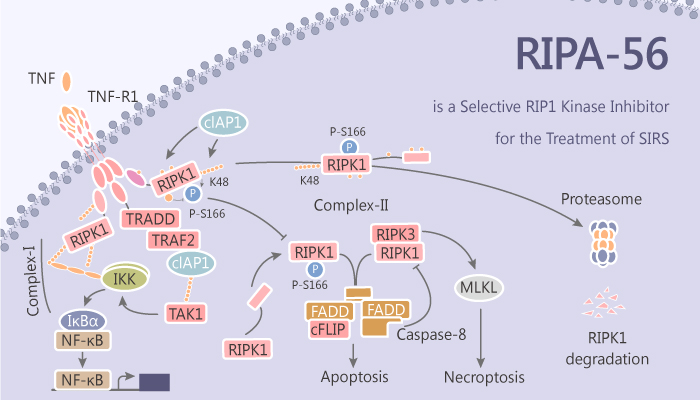Necrosis is the death of cells and tissues. The kinase activity of receptor-interacting protein kinase 1 (RIP1/RIPK1) and/or RIP3/RIPK3 mediates this regulated form of
necrosis. These results suggest RIP1 and RIP3 as possible therapeutic targets in various inflammatory diseases. Yan Ren, et al have described the optimization of an antinecrosis screening hit into a promising lead RIPA-56. Especially, RIPA-56 inhibits RIP1 by locking RIP1 kinase in an inactive form as a type III kinase inhibitor.

RIPA-56 shows efficient inhibition of RIP1 kinase activity, with an IC50 of 13 nM. However, RIPA-56 shows no inhibition of RIP3 kinase activity at a 10 μM concentration. Moreover, RIPA-56 can block the phosphorylation of both RIP1 and RIP3. Besides, RIPA-56 inhibits TNFα/Smac mimetic/z-VAD-FMK (TSZ)-induced phosphorylation of RIP1 and RIP3 in HT-29 cells. RIPA-56 possesses favorable properties with high potency in both human cells and murine cells, high selectivity, high metabolic stability, high efficacy in mice SIRS model, as well as other safety profiles.
In the SIRS mice disease model, RIPA-56 efficiently reduces TNFα-induced mortality and multiorgan damage. Furthermore, RIPA-56 shows an impressive PK profile in mice, with a 3.1 h half-life and efficient protection of mice from TNFα-induced mortality and multiorgan damage in the SIRS disease model. Notably, RIPA-56 also demonstrates potency in protection of murine L929 cells from TZ-induced necrosis (EC50=27 nM).
To summarise, RIPA-56 is a highly potent, selective, and metabolically stable inhibitor of receptor-interacting protein 1 (RIP1) for the treatment of systemic inflammatory response syndrome.